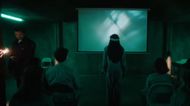It turns out that gifted kids, shadowy institutions, and ominous labs are fertile storytelling ground — but what happens when two shows take that same DNA and spiral in completely different directions? On one end, there's Stranger Things, Netflix’s cultural juggernaut that smuggled Cold War-era paranoia inside a synth-scored package of bike rides and best-friend pacts. On the other, there’s The Institute, MGM+’s adaptation of Stephen King’s 2019 novel — a series that weaponizes the same tropes not to entertain, but to disturb.
Both shows feature children with supernatural abilities, sinister experiments, and adults playing god. But while Stranger Things winks at Spielberg and wraps its horror in friendship, The Institute dares to stare at the system itself — and what it means to be complicit in its cruelty. It doesn’t hold your hand. It grabs your collar.
These are two dark worlds that seem to exist in parallel timelines — not because they look alike, but because they ask opposite questions of the same blueprint. And when they align, the effect is chilling.
The Institute vs. Stranger Things
Power: As a gift… or as a sentence?

In Stranger Things, supernatural abilities feel like a double-edged sword — dangerous, sure, but also empowering. Eleven’s psychic powers help her find her chosen family, reclaim her identity, and punch interdimensional monsters in the face. Powers are hard-won, but ultimately liberating.
Flip the script, and The Institute offers a colder calculus. Powers aren’t strengths; they’re data points. Luke Ellis and the other children aren't celebrated. They’re detained. Powers don’t set them free — they’re the reason they’re being drained. In this world, psychic gifts are just leverage for a system built on subjugation. There are no heroic arcs here, only survival.
The adults are watching — but not in the same way

Stranger Things paints most adult authority figures as clueless, crooked, or comically unhelpful — until a few (Hopper, Joyce) step up to play hero. There's the illusion of trust, the chance for redemption, the idea that love might triumph even in government corridors.
But The Institute doesn’t deal in illusions. Adults here aren’t out of their depth — they’re deeply embedded. Mary-Louise Parker’s Mrs. Sigsby doesn’t need to raise her voice; she follows procedure. Her authority is quiet, clinical, and convinced of its righteousness. This isn’t a rogue lab. It’s an institution. And it’s terrifying precisely because it sees itself as moral.
A monster in the lab vs. a monster in the system

Let’s talk villains. In Stranger Things, the big bads are literal monsters — Demogorgons, Mind Flayers, Vecna — hiding in the Upside Down, waiting to pounce. It’s the stuff of nightmares, rendered with a pulpy flair that makes the horror almost fun to watch.
In The Institute, there are no otherworldly beasts. The terror comes from the banality of the bureaucracy. Torture is logged. Experiments are methodical. Kids are bar-coded. The enemy isn’t hiding in another dimension — it’s right here, wearing a lanyard and talking about efficiency. It’s not horror by fantasy; it’s horror by function.
Escape and resistance: Two paths diverge

In Hawkins, friendship is the resistance. From the first walkie-talkie SOS to the final, dusty showdown, Stranger Things champions togetherness. The kids escape because they cling to each other. The message? Love is louder than fear.
The Institute, on the other hand, offers no such balm. Luke must outwit a system that doesn’t care about who he is, only what he can do. He doesn't get camaraderie — he gets calculation. And outside, former cop Tim Jamieson slowly awakens to the truth. The show splits its fight across two fronts: one battling from inside the cage, the other deciding whether to open the door or look away.
Conclusion: Not enemies, but echoes
What makes the two shows fascinating isn’t their rivalry — it’s their reflection of each other. They both ask: What happens when young minds are caught in the machinery of fear? But where Stranger Things offers catharsis, The Institute offers confrontation.
So no, these aren’t mirror images. They’re moral opposites. But side by side, they reveal something crucial: powers might be fictional, but the systems that abuse them? All too real.
